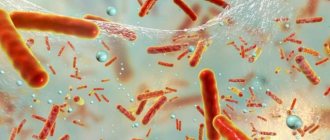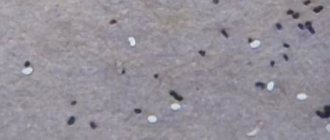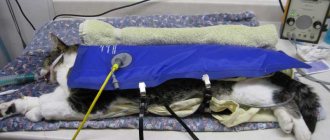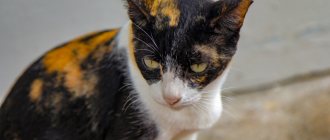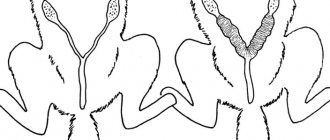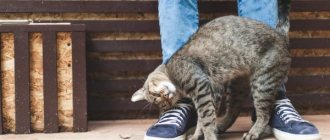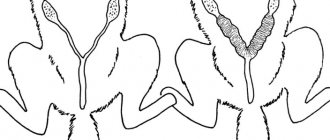6306Pavel
The cat is always the center of attention. It is impossible not to pay attention to it. Yes, she often reminds herself of herself. If a cat's tail is wet, the owner will immediately notice it.
This situation is not necessarily associated with something bad. First, you need to understand whether spilled oil or another substance is causing the problem. The cat could just get dirty. But if your tail is constantly wet, there may be several reasons.
© shutterstock
What are paraanal glands?
Anal (paraanal) glands are paired glands located at the anus. They look like small “bags” and secrete a secretion that performs various functions. One of them is recognizing the opposite sex and attracting them for further mating.
Other functions performed by the paraanal glands:
- protection from enemies (scaring away),
- marking the occupied territory,
- maintaining metabolism in the body,
- attracting partners.
During inflammatory processes, the functions of the glands are disrupted. Because of this, the pet experiences serious discomfort. In advanced cases (for example, with the development of an abscess), this problem can lead to serious and irreversible consequences. However, it is possible to avoid them if you know all the most important things about the causes and signs of inflammation.
Natural cause in cats
Your cat may have a wet tail due to the onset of the reproductive estrous cycle, popularly called estrus. A similar condition occurs in cats during sexual arousal. At this time, the animal’s body prepares for the process of mating, fertilization and pregnancy.
Estrus occurs in 4 stages:
- proestrus - takes 1-3 days, the cat attracts cats to her, but does not let them get close;
- estrus – lasts about 5 days, mating occurs;
- diestrus – 2-19 days, excitement subsides, most often pregnancy occurs;
- anestrus - sexual rest.
A discharge under the tail appears during the mating stage. At this time, the animal does not look like itself, purrs, and shows excessive tenderness. It often licks its genitals, from which a clear secretion is released. The first heat can begin at the age of 4 to 18 months, depending on the breed. What to do in this case?
There may be several options. The cat can be matched with a male, sterilized, or wait until everything goes away on its own. But for this you will have to be patient. Typically, estrus goes away within 5-15 days. If this does not happen, you should contact your veterinarian.
Common Causes of Inflammation
Inflammation or abscess of the paraanal glands often develops with trauma and mechanical damage to this area (for example, falls from a great height). This leads to dysfunction of the glands, disruption of the outflow of secretions and its subsequent accumulation. All this provokes the development of an inflammatory process involving pathogenic microflora.
Most often, long-haired cats living in apartments face the problem of inflammation of the paraanal glands. This is due to the fact that they lose the natural ability to cleanse the anal sacs (due to the absence of potential enemies and the need to defend themselves from them).
Common causes of inflammation of the paraanal glands:
- dysbacteriosis (for example, due to prolonged use of antibiotic drugs by the pet),
- helminthic infestations,
- eating small bones
- feeding mass market liquid food,
- lack of physical activity,
- injuries to the anus and anal area,
- disorders of the gastrointestinal tract, accompanied by frequent constipation.
Older cats are more prone to inflammation and abscess of the anal glands. One of the factors that can affect the development of the inflammatory process is that the pet’s gland channels are too narrow from birth. Veterinarians include cat pregnancy and excess weight (obesity) as additional provoking factors.
Without timely veterinary care, the animal will develop complications. The inflammatory process can quickly develop into an abscess (purulent inflammation), which poses a threat not only to the health, but also to the life of your pet. That is why, when the first signs of a problem appear, you need to contact a veterinary clinic in Moscow as soon as possible.
Unhealthy uterine discharge
Inflammatory diseases of the uterus lead to the accumulation of pathological substances in its cavity - waste products of bacteria, ichor, particles of epithelium, etc. Blood or pus from the vaginal opening may be a symptom of urogenital tract cancer. A cat suffers from discharge due to the following dangerous diseases:
- vaginitis;
- pyometra;
- hematometers;
- hydrometers;
- endometritis.
Vaginitis
This is an inflammatory process in the vagina, which can be acute or chronic. Ulcers form on the surface of the mucous membrane, and the cat is bothered by discharge:
- cloudy or transparent;
- viscous yellow-white;
- mucous membranes are purulent.
Mild forms of the disease are treated with douching; in severe cases, systemic antibiotics are indicated.
© shutterstock
Pyometra
Life-threatening inflammation of the uterus, requiring urgent medical attention and surgical intervention. If a cat frequently licks itself, and brown wet spots remain everywhere on the bedding and carpets, then such symptoms should alert the owner. There are also other warning signs:
- tight or bloated belly;
- increased body temperature;
- lack of appetite, but strong thirst;
- frequent urination;
- decreased physical activity of the pet, lethargy.
In some cases, the cat's purulent discharge increases in quantity so quickly that the symptoms of the disease simply do not have time to appear. The walls of the uterus cannot withstand the load and rupture, and the contents spill into the abdominal cavity . Naturally, it is no longer possible to save the pet’s life.
Hematometer
The condition is characterized by the accumulation of blood in the uterine cavity, disrupting the functioning of the organ. Often blood cannot escape due to blockage or narrowing of the cervical canal, so the discharge from the cat's uterus is very scanty. The reason may be:
- congenital anomalies;
- muscle spasm of the cervical canal;
- surgical procedures performed incorrectly;
- miscarriage or abortion;
- pathological births (especially if they happen more than 1-2 times a year);
- uterine fibroids.
Blood is a rich nutrient medium for the proliferation of harmful microorganisms, which is why sooner or later inflammation of the uterus begins.
The cat has a fever and cramping pain appears. When helping an animal, clots must be scraped out of the uterine cavity and antibacterial therapy is prescribed. If hematometra is not diagnosed in time, purulent contents form in the uterus and the disease is complicated by pyometra. Fortunately, this disease is quite rare.
Endometritis
In a cat, discharge from the uterus may be a symptom of inflammation of the walls or mucous membranes of the organ. Acute endometritis occurs more often after childbirth due to delayed release of the placenta, infection of the vagina and cervix.
Mucopurulent discharge appears in cats from the genital slit 2–6 days after the birth of kittens.
Urination becomes more frequent, milk production decreases, and the temperature rises. The animal arches its back and meows pitifully due to pain in the uterus. In the absence of therapy, the pathology becomes chronic. The infection spreads to the muscular and outer layers of the uterus and penetrates the blood. As a result, the pet dies due to sepsis. Blockage of the cervical canal threatens the development of pyometra.
© shutterstock
Hydrometer
Fluid accumulates in the uterine cavity - gland secretion, mucus, transudate in quantities of up to 10 liters. If the excretory channel is open or partially blocked, then the cat experiences white or transparent discharge. Usually they are scanty, smearable or drop-shaped. The disease often develops against the background of chronic endometritis , as a result of which the uterine walls become thinner and stretched, adhesions and scars form. Without timely treatment, the cat dies.
Signs of inflammation and abscess
Signs of inflammation develop gradually. They are accompanied by an increasing painful symptom. Due to pain and itching, the cat constantly licks the area of inflammation (tail and anus). The pet stops playing, spends time in solitude, practically does not move and constantly lies down. However, this is not the only symptom.
Other signs characteristic of inflammation of the paraanal glands:
- weakness,
- apathy,
- unpleasant specific odor from the pet’s body (does not disappear after washing),
- poor appetite (in later stages – refusal to eat),
- painful bowel movement,
- discharge from the anal glands.
With an abscess, this condition is accompanied by purulent or bloody discharge. In especially severe cases, body temperature rises. When stroking the affected area, the pet shows aggression and anxiety. Defecation is accompanied by severe pain, so the cat meows loudly on the tray.
Treatment: main stages and methods
Treatment of inflammation or abscess of the paraanal glands should only be carried out by an experienced veterinarian in Moscow. We strongly do not recommend trying to help your pet at home. This will only worsen an already difficult situation.
The first step in treating inflammation is diagnosing the animal's condition. The veterinarian examines the affected area, interviews the owner (about the severity of symptoms, the degree of their manifestation, etc.), after which he assesses the cat’s condition and prescribes treatment.
Cleaning
If you consult a doctor in a timely manner (at the first stage of the inflammatory process), then treatment will be limited to cleaning the paraanal glands. This procedure does not require special conditions, so it can be performed in the clinic or at home, but only by a professional veterinarian.
Before cleansing the glands of accumulated secretion and secretion, it is necessary to palpate them. This will allow you to determine the consistency of the contents and select a cleaning method. If the secretion is liquid, then the external method is used, if it is dense, the method of rectal sanitation is used.
After cleaning is completed, the affected area is thoroughly treated using an antiseptic solution. To prevent further inflammation (preventive measure), an anti-inflammatory suppository is inserted inside.
Washing
Unlike external cleaning, washing the paraanal glands cannot be done at home. It is carried out only in a veterinary clinic, since it is prescribed in difficult situations (for example, when a fistula forms).
Before washing the abscess, the glands are cleared of accumulated secretions, then an injection is given with local anesthesia. Next, the specialist injects an antiseptic solution into the anus using a catheter (an alternative is a syringe without a needle).
Washing is carried out not once, but several times. This is necessary so that the liquid flowing back (antiseptic solution) becomes completely transparent. This condition indicates that there is no secretion or purulent discharge left.
After washing, the pet is given an anti-inflammatory suppository, and the damaged area is carefully treated with antiseptic ointment. If the cat's condition is of concern, the specialist will prescribe a course of antibiotics.
Removal
Unfortunately, washing does not always give a positive result. In particularly severe situations (for example, with a developed abscess), the veterinarian resorts to an extreme method of treatment - surgical removal of the paraanal glands.
The surgery is performed using general anesthesia. The surgeon makes two incisions in the area where the glands are located, and then removes them along with the ducts. Then he puts stitches and treats with an antiseptic solution.
After surgery, your cat will need home care. In order for it to fully recover, it is necessary to regularly treat the area with regenerating agents (solutions, ointments), give vitamins and antibiotics for 7-10 days.
Warning
It is worth remembering that you need to be very careful when cleaning your cat’s anal glands at home. Treatment of inflammation can also be carried out in veterinary clinics, especially if there is no experience or desire to do this. Problems can await not only squeamish owners - the process itself often causes difficulties:
- under the influence of fear and pain, the animal can seriously injure the owner, who did not secure it firmly enough;
- There are many vessels and nerve endings intertwined around the anus; inept actions can injure them, which will lead to a deterioration in the pet’s health.
If you still need to carry out the procedure yourself, you should first learn from a specialist, ask questions, clarify the technique and procedure.
The frequency of cleaning is individual in each case. For some animals, it is enough to do this once, while others have to cleanse the glands regularly.
It is very important to pay attention to your pet's behavioral habits. If there is increased attention to the back of the body, it is worth checking it for symptoms of inflammation of the glands. On average, sick animals need to clean their anal sacs once every six months, while healthy animals cope with this on their own.
Recovery after treatment
After cleaning, rinsing or removing the anal glands, your cat requires special care. This will allow her body to recover faster and avoid unwanted consequences. The first thing that is necessary is to ensure the pet's comfort. Set up a bed for him in a warm place without drafts or blowing.
Maintain a therapeutic diet for 10-14 days. Eliminate solid food completely and provide constant access to fresh drinking water. Avoid excess carbohydrates in your animal's diet. It must be completely balanced so that the cat quickly recovers from a severe inflammatory process.
Prevention of inflammation of the paraanal glands
Inflammation and abscess of the paraanal glands are a serious blow to your cat's health. However, it is possible to avoid it. The main thing is to follow simple recommendations for prevention from experienced veterinarians.
Adviсe:
- Your pet should lead an active lifestyle (in accordance with its age). If you don't have much time, special toys and exercise equipment for cats will help with this.
- If your animal's anal glands are often clogged, consult a specialist and discuss the issue of removing them.
- Try to avoid cheap liquid food and do not give your pet small bones, as well as foods that can cause gastrointestinal injury.
- At the first signs of inflammation, consult a doctor. Don't forget about regular preventive examinations.
- Carry out anthelmintic treatment once every 6-12 months. This completely eliminates the possibility of developing parasitic diseases.
Inflammation or abscess of the paraanal glands is dangerous to the health and life of the cat. A seemingly insignificant problem can lead to dangerous consequences, including death. That is why we strongly recommend that you follow preventive measures, and if the first signs of inflammation appear, contact your veterinarian immediately!
Prevention, advice to owners
In the treatment and prevention of “wet tail”, it is important to follow the rules of hygiene - clean the cage in a timely manner, replace food and water daily, wash your hands after interacting with animals (since the infection is easily transmitted from one rodent to another).
If several animals are kept in one cage, then the sick should be immediately isolated and the cage should be thoroughly cleaned.
Further care should begin with healthy pets, and then only carry out hygiene procedures on sick animals.
It is not advisable to keep a sick pet in the same room as healthy ones.
Several times a day, the cage of a sick rodent is disinfected with antiseptics and the bedding is changed - these actions help to avoid re-infection.
